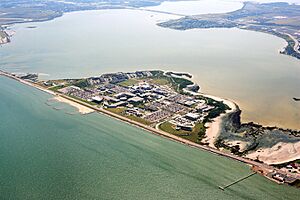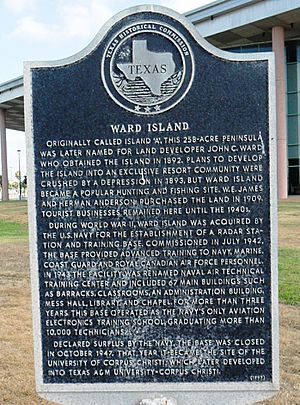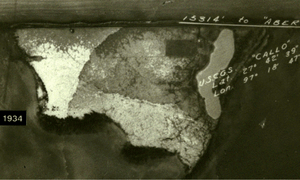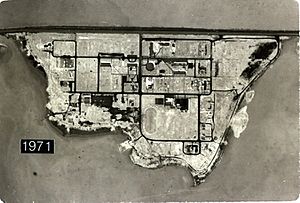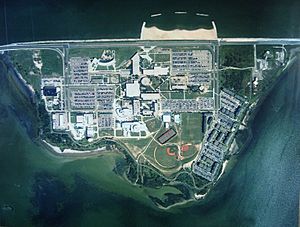Ward Island (Texas) facts for kids
Ward Island is a special piece of land located in Corpus Christi, Texas. It sits right where two bays, Corpus Christi Bay and Oso Bay, meet. Today, almost all of Ward Island is used by Texas A&M University-Corpus Christi, a big university.
Even though it's called an "island," it's actually more like a peninsula. This means it's connected to the main land of Corpus Christi by a strip of wetlands, about 1,500 feet (460 meters) long. Ward Island is shaped a bit like a triangle and is about 5,000 feet (1,500 meters) long. It covers about 240 acres (almost 1 square kilometer). The ground here is mostly clay, not sand. The highest point on the island is only about 15 feet (4.6 meters) above the water. A road called Ocean Drive connects the island to the city and also leads to the Naval Air Station Corpus Christi at Flour Bluff.
Contents
Island History: From Resort to University
Ward Island was first known as "Island A." Later, it was named after a man named John C. Ward, who bought the island in 1892. He hoped to build a fancy resort community there, but his plans didn't work out because of money problems in 1893. Even so, the island became a popular spot for fishing and hunting.
In 1909, two new owners, W. E. James and Herman Anderson, bought the land. They set up simple shelters for people who came to hunt and fish. This business continued until the 1940s.
Ward Island During World War II
As World War II was starting, the United States Congress decided the U.S. Navy needed a new place to train pilots and other staff. They chose a large area at Flour Bluff, south of downtown Corpus Christi. Construction of the Naval Air Station Corpus Christi (NASCC) began in June 1940. It officially opened in March 1941. The road connecting to the base, Ocean Drive, which passed by Ward Island, was also improved.
Right after the war began, the Navy needed many skilled technicians. These technicians would maintain the new electronic systems, especially radar, which were very important for the war effort. Ward Island, which was empty at the time, was chosen to be a secret school for training these advanced electronics technicians.
Ward Island was perfect because it was isolated and easy to keep secure. Even though it wasn't part of NASCC, the main base was very close. This meant NASCC could help the school with many of its needs. By July 1942, the school was ready for its first students. It was named the Naval Air Technical Training Center Ward Island, or NATTC Ward Island. Throughout the rest of the war, this secret school trained thousands of people. These included Navy, Marine, Coast Guard, and even Royal Air Force personnel. NATTC Ward Island closed in October 1947 after the war ended.
From Military Base to College Campus
After the Navy left, Ward Island quickly became a center for higher education.
- First, it was home to the University of Corpus Christi (from 1947 to 1973).
- Then, it became Texas A&I at Corpus Christi (from 1973 to 1977).
- After that, it was Corpus Christi State University (from 1977 to 1993).
- Finally, since 1993, it has been the home of Texas A&M University-Corpus Christi.
In 1973, a small part of Ward Island was also set aside for special religious training for university students. Since 2003, this area has been used by the South Texas School for Christian Studies.
When World War II began with the attack on Pearl Harbor in December 1941, the Navy had only one school for electronic technicians. This was the Radio Materiel School (RMS) in Washington D.C. This school trained excellent technicians, but it didn't teach about radar or airborne electronics. The war needed thousands of these technicians, and the RMS could only train a few hundred each year.
A special group was quickly formed to solve this problem. Led by William C. Eddy, a retired submarine officer, they created a new training program called the Electronics Training Program (ETP). It started very quickly, on January 12, 1942.
How the Electronics Training Program Worked
The ETP had two main parts:
- A three-month Primary School, taught at colleges across the country.
- Three Secondary (or Advanced) Schools.
To get into the ETP, students had to pass a difficult test called the Eddy Test. Soon, a one-month Pre-Radio School was added. This was taught in junior colleges near Chicago. Both the Eddy Test and the Pre-Radio School were very tough. Only the most capable students were allowed to continue. The Primary Schools packed two years of engineering college topics into just three months of long, 12-hour study days.
The Secondary Schools were taught by Navy and Marine instructors. They started as five-month programs but grew to seven months as more topics were added. Two of these schools focused on electronics for ships and shore bases. The third Secondary School, which focused on airborne electronics (electronics used in planes), was at NATTC Ward Island. All the Secondary Schools operated under very high security.
Life and Learning at NATTC Ward Island
The Navy bought Ward Island in February 1942. Construction of the school buildings began in May, and the school officially opened on July 1. The first buildings included an Administration Building, two teaching buildings, five barracks (where students lived), and two mess halls (dining areas). Only part of the 240-acre site was cleared at first, and most of the roads were unpaved. The wilder back part of the island even had rattlesnakes!
Teachers, equipment, and students were moved from a smaller Navy school at the United States Naval Academy in Annapolis, Maryland. The first new class from the Primary Schools also started at this time. In September 1942, the school became officially known as the Naval Air Technical Training Center Ward Island (NATTC Ward Island). The first class of 106 students graduated in late September. After that, a new class of 200 students started every two weeks. By mid-1944, a new class started every week, and the school had about 3,100 students at its busiest.
Eventually, NATTC Ward Island had 87 buildings. These included a medical center, a library, a chapel, an auditorium, a store, a gym, and many barracks for students. Outside, there were sports fields, courts, and two swimming pools. Every student had to pass a swimming test.
NATTC Ward Island mainly trained U.S. Navy and U.S. Marine personnel. Students from the United States Coast Guard and the Royal Air Force from Great Britain also attended. Sometimes, officers would attend special advanced radar courses. Starting in 1943, a special three-month course was given for WAVES (Women Accepted for Volunteer Emergency Service) supply officers. The school also offered refresher courses for both officers and enlisted men.
Teaching at the Secondary School was split evenly between lectures and hands-on laboratory work. Lectures covered advanced electronics, microwave theory, and other complex topics. In the labs, students worked on aircraft communication systems, high-frequency and microwave radar systems, identification, friend or foe (IFF) systems, radar altimeters, and long-range navigation (LORAN) equipment. They also had special courses on secret topics like the Norden bombsight and the magnetic anomaly detector (MAD), and even the Navy's first drone aircraft, the Target Drone Denny 1.
All the teaching happened in a highly restricted area on the north end of the island. This area had 16 teaching buildings and a large hangar with planes for training. For flight training, there was another hangar and a small fleet of planes at the nearby Naval Air Station.
The School Closes
NATTC Ward Island continued for some time after World War II ended. In mid-1946, a Primary School was added. The Secondary School graduated an estimated 10,000 students. All Navy activities on Ward Island closed in the fall of 1947. The training program was moved to another Navy base in Tennessee.
Ward Island: A Center for Learning
In April 1947, a new school called the Arts and Technological College (ATC) was started. It was first planned for another city, but in July, it was decided to open in Corpus Christi. ATC temporarily opened in September at a former Navy airfield. Its name was changed to the University of Corpus Christi (UCC) at that time. It started with 312 students and 24 teachers.
University of Corpus Christi (UCC)
When the Navy closed NATTC on Ward Island in October 1947, the UCC leased the property, including all the buildings, for just one dollar a year. The UCC later gained full ownership. During the Christmas break, the school moved from the airfield to Ward Island. Classes restarted in the former Navy training buildings on January 5, 1948. The first UCC graduation was held in May for 29 students. For 26 years, UCC was the only four-year university in Corpus Christi.
For many years, UCC used the original Navy buildings. The first new permanent building, a women's dormitory, was built in 1956. A significant new library building opened in May 1963. In 1970, many of the old wartime buildings were badly damaged by Hurricane Celia. UCC often had money problems. To rebuild the campus after the hurricane, the university asked the State of Texas for help.
The Texas Legislature passed a law allowing Texas A&I University to open a branch in Corpus Christi. The UCC then transferred Ward Island to the city of Corpus Christi, which then gave it to Texas A&I. The last graduation for UCC was in 1973. When the land was transferred, a religious organization kept 10 acres for student religious centers. At the same time, Corpus Christi officially made Ward Island part of its city limits.
Texas A&M at Corpus Christi (TAMUCC)
Texas A&M at Corpus Christi (TAMUCC) began offering classes in the fall of 1973. It started with 969 students who were in their junior, senior, or graduate years. Many of the damaged buildings were not rebuilt, so there was no on-campus student housing at first. Sports teams were also stopped. However, there was a big need in Corpus Christi for a school where students could finish their bachelor's degrees and get master's degrees. By early 1974, TAMUCC had over 1,200 students who commuted (traveled from home). The school grew steadily and became known as the "Island University."
Corpus Christi State University (CCSU)
In 1977, the school became part of a new university system and was renamed Corpus Christi State University (CCSU). A few dorms and other permanent buildings were added, but CCSU still used many of the original Navy buildings. It remained mostly a school for commuting students. Still, it grew steadily over the next ten years. By 1989, the school had more than 4,000 students and over 10,000 alumni (former students).
Texas A&M University-Corpus Christi (TAMU-CC)
The State Legislature made CCSU part of the growing Texas A&M University System in 1989. In 1992, the school was allowed to offer its first doctoral program (the highest university degree). In 1993, the Texas A&M University System renamed the school Texas A&M University-Corpus Christi (TAMU-CC). Starting in the 1994-1995 school year, freshmen and sophomore students were also admitted. This made it a full university offering all levels of undergraduate and graduate degrees. The sports program restarted in 1997. The teams are called the "Islanders" and compete in the Southland Conference.
In the years that followed, A&M Corpus Christi continued to grow. All the old wooden Navy buildings were replaced. New facilities include student housing, large classroom buildings, a 1,500-seat Performing Arts Center, and the Harte Research Center. The university is recognized as a Hispanic-Serving Institution. As of 2012, there were over 10,000 students from many different states and countries. There are five main colleges: Business, Education, Liberal Arts, Nursing and Health Sciences, and Science and Engineering. The university has about 1,400 staff members.
South Texas School of Christian Studies
When the land for Ward Island was sold to the university, a religious organization kept 10 acres. This area, located near the TAMU-CC campus, is now home to the South Texas School of Christian Studies. This is an independent group that provides religious education. Hundreds of students are enrolled in different programs there. The Center itself doesn't give out degrees, but it offers educational services for other accredited institutions.


